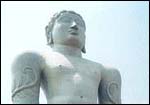


|
|
 |
| HOME | TRAVEL | TRAVELOG | ||

The Land of the Hoysalas ... a temple tour of Karnataka K S Krishnan
One bike, two people with a spirit of adventure and a bag left Bangalore at five in the morning. When the moon reluctantly waned and the orange sun appeared behind us on the eastern horizon, we were already out of the din of the city and into the endless plateau of the Deccan. We stopped for tea. Had to wake up the chaiwallah. And enjoyed the quiet countryside and the glorious sunrise as we sipped our tea. Belur, on the banks of Yagachi river, is everything you would expect the remains of a grand empire not to look like. It was a typical dusty Karnataka town swarming with shops and cattle and people. And evidence of the prestige it once had as the impressive capital city of the Hoysalas was not discernible. We took a Karnataka State Tourism Development Corporation hotel room and made ourselves comfortable. But I was not too optimistic about the whole affair. As we went into the Chennakeshava temple all my fears vanished. The temple was an amazing work of craftsmanship and the sheer detail of the work was mind-boggling. The statues of the princesses and the gods transported one to a bygone era. One could imagine that when the temple project began, Belur would have instantly been transformed into a bustling town with thousands of sculptors working on pieces of stone in the blazing sun. In fact this temple was commissioned by King Vishnuvardhana when he became a Jain as well as for various military conquests that he achieved during his reign.
If Belur was majestic, Halebid lying just 16 km away was simply awesome. Surrounded by a beautiful garden the soapstone main temple, Hoysaleshvara was even more intricate than Belur. Two giant Nandis calmly looked on. Some of the stone work, like the intricate dress patterns in layers on some of the statues, showed the heights these sculptors had reached. And when one discovers the chapters of history that this temple had lived through it appeared all the more charming. The town of Halebid was once called Dora Samudra. But when the forces of the 'notorious' Alauddin Khilji advanced into Dora Samudra in 1311, they demolished the town and renamed it. But the Hoysaleshvara temple remained standing.
Our last stop for the day was a Jain temple nearby. It was a small temple and was undergoing some renovations. There were distinctive similarities between this little shrine and with the other Hoysala temples around. But the architecture of this temple was much simpler. Our sightseeing done for the day we went straight back to of our hotel and rested rather tired from our exertions.
This structure, carved from one rock, 57 feet high, is one of the largest monolithic statues in the world and stands on the top of a hill. The landscape around this place is quite different from the rest of the region and much greener and fertile looking -- sugarcane country. From a distance we spotted the hill with its magnificent statue. One has to climb 614 steps, cut out in the rocks, to reach the top of the hill. Bahubali looked out serenely, standing as a symbol of renunciation, as he has been for the last thousand years. Every 12 years this town comes alive for Mahamastakabhisheka. The statue is bathed by 1,008 pots or kalashas of holy water and then ghee, milk, coconut water and haldi. A thousand priests climb a specially erected ladder structure to bathe the statue. The last ceremony was in in 1993. The twin hill standing besides this hill also has a few monuments of its own. There are about 15 Jain temples close to each other. As we entered them all the sounds from outside were gradually cut off... until all that remained was pure silence, overpowering and overbearing. We were reluctant to make a noise and break the spell and we walked on tiptoes. The statues of contemplating monks, their faces so peaceful, reminded one of the Buddha. Outside in the blinding heat we trudged to the cave temple where the sacred feet of Srutakaavali were present. The cave was simple and earthy and also was respite from the now blazing sun.
As we made our way back to Bangalore we pondered over what we had experienced. Something which hundreds of history books could not have prepared us for. This was just one of the thousands of mysterious secrets this magnificent country of ours possesses. And we had just made a small step towards understanding the splendour that is India.
|
|
|
Fast Facts
|
|
|
|
|
|
HOME |
NEWS |
BUSINESS |
CRICKET |
MOVIES |
CHAT
INFOTECH | TRAVEL | LIFE/STYLE | FREEDOM | FEEDBACK |
|